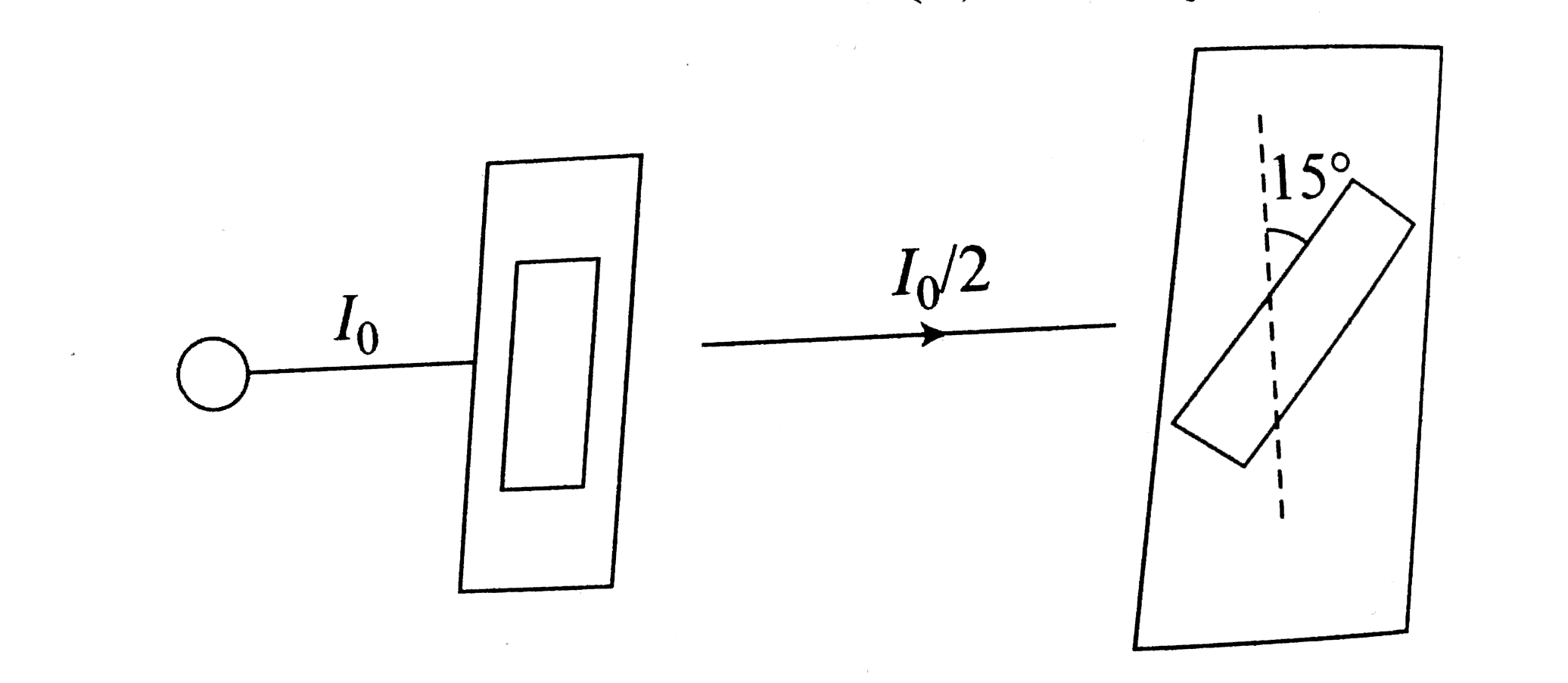A plane polarized beam of intensity I is incident on a polarizer with the electric vector inclined at 30∘ to the optic axis of the polarizer. Light coming out of the polarizer through an analyser whose optic axis is inclined at 30∘ to the polarizer. Find the intensity of light coming out of the analyser.
To solve the problem step by step, we will use Malus's Law, which states that when polarized light passes through a polarizer, the intensity of the transmitted light is given by:
I=I0cos2(θ)
where I0 is the intensity of the incident light and θ is the angle between the light's electric field vector and the polarizer's optic axis.
Step 1: Calculate the intensity after the first polarizer
Given:
- Initial intensity of the polarized beam, I0=I
- Angle between the electric vector and the optic axis of the polarizer, θ1=30∘
Using Malus's Law:
I1=I0cos2(θ1)
I1=Icos2(30∘)
Now, calculate cos(30∘):
cos(30∘)=√32
Thus:
I1=I(√32)2
I1=I⋅34
I1=34I
Step 2: Calculate the intensity after the analyzer
Now, the light coming out of the first polarizer (with intensity I1) is incident on the analyzer. The angle between the light coming out of the polarizer and the optic axis of the analyzer is also θ2=30∘.
Using Malus's Law again:
I2=I1cos2(θ2)
I2=I1cos2(30∘)
Substituting I1:
I2=34I⋅cos2(30∘)
I2=34I⋅(√32)2
I2=34I⋅34
I2=916I
Final Result
The intensity of light coming out of the analyzer is:
I2=916I
---
- Initial intensity of the polarized beam, I0=I
- Angle between the electric vector and the optic axis of the polarizer, θ1=30∘
I1=I0cos2(θ1)
I1=Icos2(30∘)
cos(30∘)=√32
I1=I(√32)2
I1=I⋅34
I1=34I
I2=I1cos2(θ2)
I2=I1cos2(30∘)
I2=34I⋅cos2(30∘)
I2=34I⋅(√32)2
I2=34I⋅34
I2=916I
I2=916I
Topper's Solved these Questions
- WAVE OPTICSBook:AAKASH SERIESChapter:WAVE OPTICSExercise:PROBLEMS (LEVEL - II)
Explore 33 Videos
- WAVE OPTICSBook:AAKASH SERIESChapter:WAVE OPTICSExercise:EXERCISE (VERY SHORT ANSWER QUESTIONS (POLARIZATION))
Explore 8 Videos
- WAVE MOTION AND SOUNDBook:AAKASH SERIESChapter:WAVE MOTION AND SOUNDExercise:PROBLEMS (LEVEL - II)
Explore 97 Videos
- WAVESBook:AAKASH SERIESChapter:WAVESExercise:EXERCISE-III (Doppler effect :)
Explore 15 Videos
Similar Questions
A plane polarized light with intensity I0 is incident on a polaroid with Electric Field vector making an angle of 60∘ with transmission axis of polaroid. The intensity of the resulting light will be
View SolutionWhen an unpolarized light of intensity I0 is incident on a polarizing sheet, the intensity of the light which dows not get transmitted is
View SolutionThe intensity of the polarized light transmitted through the analyzer is given by
View SolutionUnpolarised ligh of intensity 32W/m2 passes through a polariser and analyer which are at ain angle of 30∘ with respect to each other. The intensity of the light coming from analyser is
View SolutionA plane polarized light is incident normally on a tourmaline plate. Its E vector make an angle of 60∘ with the optic axis of the plate. Find the percentage difference between initial and final intensities
View SolutionUnpolarized light with intensity I0 is incident on combination of two polarizers as shown . The intensity of the light after passage through both the polaroids will be.

View SolutionA plane polarized light is incident on an analyser and when it is rotated to complete one rotation, one observes
View SolutionA polarized light of intensity I0 is passed through another polarizer whose pass axis makes an angle of 60∘ with the pass axis of the former, What is the intensity of emergent polarized light from second polarizer?
View SolutionLight is incident on a polarizer with intensity I0. A second prism called analyzer is kept at a angle of 15∘, from the first polarizer then the intensity of final emergent light will be

View SolutionTwo polaroids are placed in the path of unpolarized beam of intensity I0 such that no light is emitted from the second polarid. If a third polaroid whose polarization axis makes an angle θ with the polarization axis of first polaroid, is placed between these two polariods then the intensity of light emerging from the last polaroid will be
View Solution